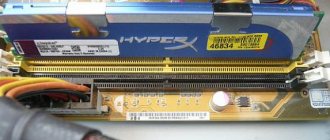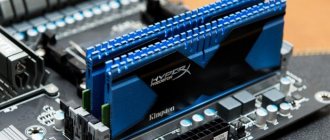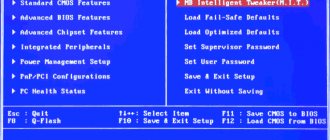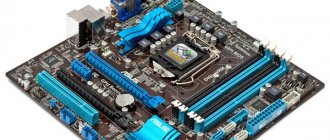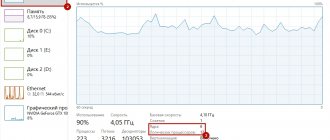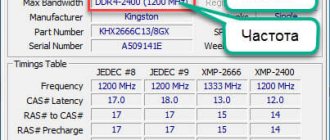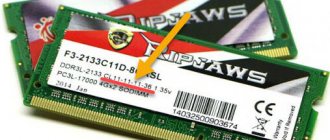What it is?
RAM (random access memory) or RAM is a part of a computer component system designed for temporary (as opposed to ROM - permanent storage) storage of various types of data.
RAM is volatile. This means that after a power failure (disconnecting the device from the mains), all information from the RAM disappears. RAM is used by the computer's central processor to process incoming, outgoing, and intermediate data.
Simply put, all programs (including system ones) that run on a PC (laptop, tablet) at a given time use RAM in one way or another.
RAM allows you to significantly increase the speed of your computer due to the ability to unload part of the data into the cache. That is, this or that program works with information that is stored on the hard drive (non-volatile permanent memory), the process of reading data from a mechanical device is quite slow, so the data is uploaded to RAM.
Externally, RAM is a small flat strip that is installed in special slots on the computer motherboard.
How does a smartphone use RAM?
If RAM is used to store data from open applications, then the more RAM there is, the more applications can run in the background without slowing down the smartphone. It is true, but even here everything is not so simple.
We list the main processes where RAM is used during the first startup:
- Virtual files.
There are several folders and files in Android that are not real. These are pseudo-files created during boot and they contain data such as battery level and processor speed data. On Android, such files are stored in the /proc directory. Space in RAM is always reserved for this - Core.
Android runs on top of the Linux kernel. The kernel is stored in a special compressed file, which is extracted directly into RAM when the device is turned on. This reserved memory contains the kernel, drivers, and kernel modules that manage hardware and space for caching data to and from the kernel. - Graphics processor.
The graphics chip requires memory to operate - it's called VRAM. Integrated GPUs used in smartphones do not have separate VRAM. Therefore, they also have to access RAM. - Communication and information.
Finally, data about your IMEI and communication settings is stored in NVRAM memory (non-volatile memory that is not erased when the phone is turned off), but is transferred to RAM along with the software necessary to support the modem when the smartphone is turned on.
After all these processes, what remains is the memory that will be used by the phone to operate and run applications. Please note that many shells have been developed for the Android system, which means that additional processes can be added to them, for which space will also be reserved when the device is turned on for the first time.
All this explains why the amount of available RAM does not match the total amount of RAM installed in a particular device. Typically, about 1 GB of RAM is allocated for all internal processes. Everything else is for applications.
Difference between RAM and ROM
A hard disk (ROM) is a permanent storage of data, but the speed of managing this data is not enough for the normal operation of the machine. Imagine yourself as a chef preparing a certain dish. You have a huge warehouse with various products. But in order not to run far and not look for the necessary products in this whole heap, you selected them and put them on your table. It turns out that the table is your RAM, and the warehouse is your hard drive.
The work of a computer is built in this likeness. The processor loads everything it needs into temporary RAM, which is much faster than the HDD. Due to this, the performance of the computer increases.
Main characteristics of RAM
From the user’s point of view, when purchasing RAM, you need to focus on its volume, price and manufacturer. But to understand the purpose of RAM in computer operation in general and in games in particular, it is worth understanding all the other parameters.
Volume
Since the RAM contains a lot of information at any given time (data from the hard drive, the cache of various programs, input and output data), sooner or later there comes a time when all this information no longer fits in the RAM.
This is where the system slows down, freezes and unexpected failures begin.
For such cases, there is a paging file on the hard drive that can be configured for different amounts of information, but it does not solve the problem, since accessing the hard drive takes much more time than accessing RAM.
For a gamer, such delays of hundredths of a second can lead to fatal consequences, especially in online shooters and other dynamic games. The player has to wait for the location to load; he does not have time to shoot or dodge the blow. Therefore, in a gaming PC, the amount of RAM is especially important.
It is measured in MB (megabytes) and GB (gigabytes). To play modern computer games comfortably, it is recommended to have at least (preferably more) 4 GB of RAM.
Memory delay
Timing is an indicator of the number of clock cycles that occur during the time it takes to return data upon request from the CPU, or more simply: how long it takes to read data from memory cells.
The timing value is indicated on the memory board in the following form:
7-7-7-24 or 2-2-2-5
The main indicator is the first digit in the line, sometimes even only one is indicated. The lower the timing, the faster the memory works!
This indicator is often not taken into account by less experienced users when purchasing RAM, but for games it is critically important: with other indicators being equal (volume, frequency), you need to choose memory with lower timing.
Frequency
The frequency of RAM is expressed in MHz and indicates the number of cycles of writing and reading data per second. It is clear that the higher this indicator, the faster the memory and computer will work.
It should be remembered that it is pointless to purchase RAM with a clock frequency of 3200 MHz if the motherboard only supports a frequency of 1060 MHz. It is impossible to consider each of the three RAM performance indicators separately: it is their totality that matters. This is especially true for gaming computers.
How much RAM do you need for games?
Once again, upgrading from 4GB to 16GB and running a game that uses the 8GB maximum will have a small but noticeable impact, on the order of a few frames per second. Likewise, the game will load faster.
Conversely, if you have 8GB of RAM and upgrade to 16GB and the game only uses 8GB, then there will be zero difference, or at least no improvement noticeable from the user's end.
As you can see, this fade-out is incredibly fast and essentially means wasting money on gigabytes that will remain idle and untouched for the duration of your gaming session.
How does it affect RAM in games?
If we take games into account, then there should be a lot of RAM. When the toy is loaded, all data about the location, map and other scenery goes from the HDD to the RAM, and then the video card converts the data and broadcasts it to the monitor screen. If there is not enough temporary memory, the game will simply slow down, or even freeze for a few seconds. Of course, all this will darken the impression of the game, which is why gaming machines are equipped with a large amount of RAM.
Effect of volume
The answer to the question: “What affects the amount of RAM?” - extremely simple. The amount of RAM directly affects the amount of information that the processor will process, and therefore increases the speed of completing all tasks in general.
Effect of frequency
RAM frequency is the speed at which the RAM exchanges files with the processor. And it’s already clear what the speed of RAM affects. Higher speed means faster information processing.
What does type affect?
Each subsequent generation of RAM differs in its characteristics: the frequency and volume increase and the voltage decreases, due to which the board heats up less.
conclusions
What is more important, volume or frequency? For games - frequency, provided that at least 16 GB of memory are installed in the system. It is also equally important to configure the memory’s primary and secondary timings. In application programs, and not synthetic benchmarks, high memory frequency also has an impact on the result. Reduces rendering time, archiving time, etc., in any software where there is a high dependence on memory bandwidth. Why then do we need volume? First of all, for comfortable work with large tasks. This applies to designers, editors, and editors. You feel especially comfortable when working with 4K video content. The system practically does not create a swap file for paging, and the editor responds with lightning speed to the use of effects and filters. Our test with opening more than 100 NEF files using Photoshop is rather artificial. No one in their right mind would open that many files in an editor, but if the need arises, 64 GB will allow it. Therefore, a meaningful approach to the required amount of RAM is the key to success.
Undemanding users with a minimum number of tabs, simple documents, viewing photos/videos without editing - for now, 8 GB of any memory at any frequency is sufficient.
- Only games with a minimum number of applications in the background - 16 GB of memory with maximum frequency and manual adjustment of secondary timings (for systems with Intel processors). AMD Zen + (2) platforms: single-rank memory up to 4000 MHz, dual-rank memory - 3466 - 3600 MHz.
- Games and a limited number of resource-intensive applications - 32 GB and this is gradually becoming the standard, just like 16 GB over the past few years. If possible, take memory with a frequency reserve. Even if now your motherboard or processor cannot use 100% of the entire memory frequency, when you change processor, board or platform later you will not need to look for more expensive modules.
- Photo/video editors, CAD software, and other specialized programs that process massive data place increased demands on memory. It's especially difficult with video content, as 4K files have become common. This means they don’t just need 64 GB, but really need it for work.
For more information about HyperX products, please visit the company's official website.
How to choose RAM for a computer?
- First, you need to think about feasibility. Correlate with the purposes for which you use the PC. Working in text editors and watching movies do not require large amounts of space, and 2GB of RAM will be enough for you, but this will not be enough for games.
- For best results, take planks from the same manufacturer, with matching parameters.
- It is important that the slats have the same operating frequency and timings.
- You should also take into account the bit depth of your OS. For example, you won’t be able to install more than 4 GB of RAM on 32-bit Windows; it simply won’t see it.
How to see the amount of RAM on a smartphone
When choosing a smartphone in a store, you can see the amount of RAM on the attached price list with technical characteristics. If it is not indicated, then ask your sales consultant. But in this case it’s worth thinking about, because... sellers try not to indicate modest characteristics, but highlight attractive parameters for the inexperienced buyer. For example, focus on camera resolution or screen size, support for LTE networks, and modestly keep silent about the amount of memory.
You can find out the amount of RAM on the manufacturer’s website, or by typing the name of the model you like in the search bar and find out the characteristics on any specialized resource.
If you don’t know the exact model or you are purchasing a used smartphone, then you should install a special application on it that shows in detail all the parameters of the gadget. The most famous application for this purpose is AIDA 64.
Install this program from the Google Play catalog, run it and go to the “System” section, where the amount of RAM on the smartphone being tested will be indicated.
Also reading with this:
- How to change the date and time on an Android smartphone or tablet It seems that such a simple action as setting the date and time on Android should not pose any difficulties. Indeed, for experienced owners of smartphones or tablets, this is a banal […]
- Desktops in Android In Android, there are several desktops, and switching between them is done by horizontally swiping (scrolling) in any direction. There can be from 5 to 7 desks per […]
- How to connect to WI-FI on a smartphone or tablet During the first launch, the initial setup wizard for your smartphone or tablet helps you connect to your home WI-FI network. How to connect to another network, for example at work or […]
- Android on-screen keyboard Mobile devices running the Android operating system use an on-screen keyboard to enter information. Those users who first encountered tablets and [...]
- How to install applications on Android smartphones and tablets The main difference between a smartphone and an ordinary mobile phone is the ability to install different applications from the huge variety provided by Google Play. Google Play – […]
Android for dummies
How to understand that there is not enough RAM?
This can be clearly seen in all well-known applications such as the photo editor Adobe Photoshop and any browser. Just start working in the editor with multiple layers or click multiple tabs. The computer will start to slow down.
To check how the RAM works, call the Task Manager (Ctirl + Alt + Del). Click the “Performance” tab and look at the RAM load. Next, we determine where exactly the memory is spent by clicking “Processes”. If necessary, disable unused programs.
